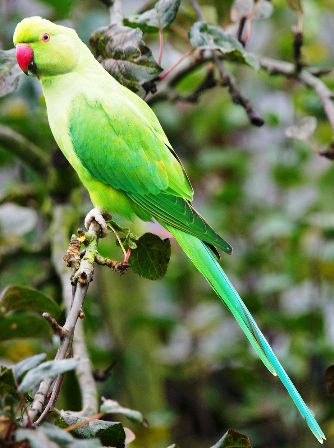Will Seychelles be the first country to eradicate invasive ring-necked parakeets? |22 August 2016
 The SIF-led Ring-necked Parakeet (Psittacula krameri) eradication on Mahé has been running for the last five years, with efforts intensifying in the last three years. More than 500 of these invasive parakeets have now been culled (after the initial population estimate of 300 birds was revised several times), and the intensive eradication efforts are finally drawing to a close, with no recent confirmed sightings of this invasive species.
The SIF-led Ring-necked Parakeet (Psittacula krameri) eradication on Mahé has been running for the last five years, with efforts intensifying in the last three years. More than 500 of these invasive parakeets have now been culled (after the initial population estimate of 300 birds was revised several times), and the intensive eradication efforts are finally drawing to a close, with no recent confirmed sightings of this invasive species.
The parakeets occurred primarily on Mahé, where they were rapidly expanding in numbers until the eradication started reducing the population. The eradication efforts also revealed the existence of birds on Silhouette and Praslin, both of which were culled quickly by sharp-eyed, quick-acting local residents. Almost all of the birds have been on Mahé, however, and there have been no confirmed sightings on any island for several weeks. The eradication team of Team Leader Laurent Leite and hunter, Nick Page, are currently following up to confirm the absence of parakeets from the country. In this they depend on their own extensive experience of the birds’ movement patterns, feeding areas, roosting spots and flightlines, but also heavily on information from the public who have acted as an extra team member, spotting and reporting several solitary birds before the team found them. Indeed the overwhelming cooperation, goodwill and support of the Seychelles’ public have been remarkable, and instrumental to the success of the project. We believe it will be the first successful “people’s eradication” in the history of Seychelles’ conservation work.
The main reason for SIF’s involvement in this eradication has been to protect the endemic Seychelles black parrots, which are found only on Praslin in a small population, and are considered vulnerable to extinction by the IUCN. The black parrots are specialised palm forest dwellers, depending on mature coco de mer forest for their nest sites, and endemic palms for most of their food. The ring-necked parakeets would have posed a major threat to the parrots on several fronts if they had established a population on Praslin; they would have been highly likely to compete for food, as well as for the limited number of nest sites on Praslin (both species nest in tree cavities), and they are known to carry at least one deadly parrot disease, which the black parrots have not been exposed to, and which could decimate their population.
The SIF team has faced tremendous obstacles and set-backs throughout the project, not least the larger-than-expected parakeet population and the birds’ unpredictable behaviour, so the commitment and persistence of the team members throughout these challenges should be commended. They have one remaining month of intensive observations on the project before the eradication shifts gear into a final periodic monitoring phase before the eradication can be confirmed. Time will dictate success, but if we can confirm that there are no more parakeets at large, the Seychelles will indeed be the first country in the world to have eradicated an established population of this highly invasive avian species.




